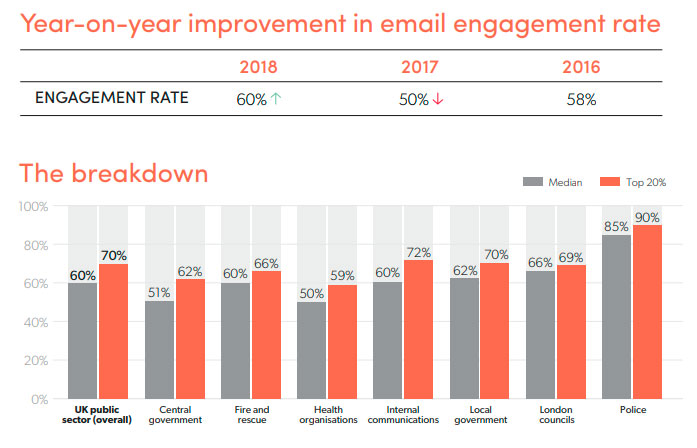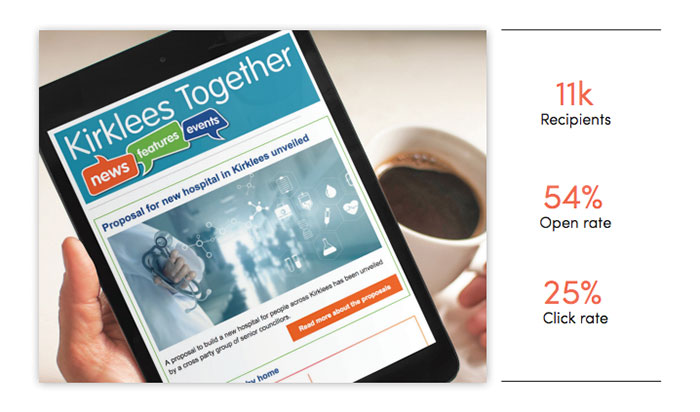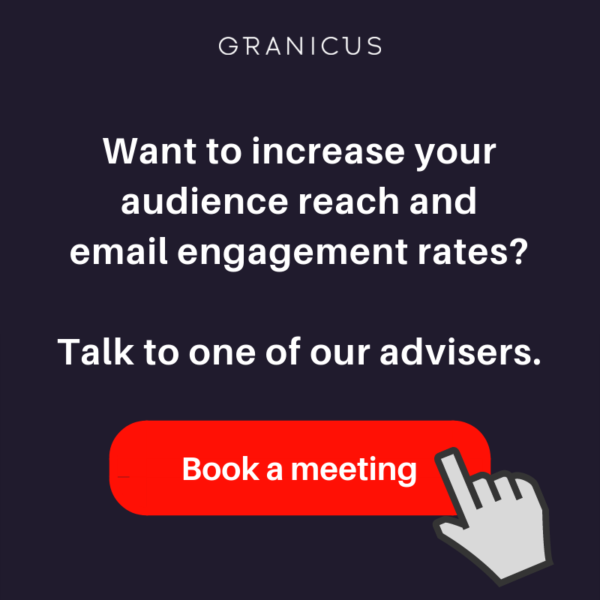Are your emails engaging? [Benchmarks and best practices]
When it comes to digital communications we all want to know how well we are engaging with our audiences.
With emails it’s quite easy to work that out, well, it is if you have ways of tracking how many people have opened the message and how many links in the message have been clicked – you’ve all got that now, right?
But, what is a good open rate? How does yours compare with other organisations similar to yours? Are you getting the best from all your hard work? Would a few tweaks to subject lines, tone of voice or calls to action have any impact?
With the launch of our latest ‘Email Marketing Benchmarks and Best Practices for the UK Public Sector’ guide, public sector organisations can now find out what the average engagement rate is for their sector.
So, whether you work in comms for central or local gov, or send emails on behalf of the police or fire service, or if you are working in healthcare – you can quickly see a breakdown of email engagement rates and compare yours with your peers. Or, you might just want to be nosy.
Why should you care? Well, because more people reading your messages means more people are likely to get involved in the programmes and services being promoted. More people are likely to act off the back of the information provided. For example, greater audience reach and engagement with your messages could be the difference between 100, 1,000 or 1 million people receiving potentially life-saving information during an extreme weather event.
Engagement rate is probably the most important metric for monitoring the performance of your email communications overall. It takes into account both opens and clicks, which is significant given that the ‘success’ of some of your messages won’t depend on clicks on a call-to-action (CTA); your emails may be informational only.
Now for the science bit… Engagement rate is calculated by taking the number of unique email recipients who opened an email or clicked on a link in an email over a 90-day period, and labelling those individuals as ‘engaged’.
That number is then divided by the total number of email recipients during that time period. If the rate holds steady or increases while your total reach grows, this is a strong indication your communications strategy is performing well and effectively maintaining subscribers’ attention. If it’s not you need to have a look at ways to improve and see examples of best practice in the industry – or talk to us at Granicus for advice 😊.

If you use GovDelivery you can easily find out your engagement rate by logging in to the system and selecting ‘Reports’ and then ‘Account Performance Report’.
Here’s a good practice example from Kirklees Council
Kirklees are doing great things with email at the moment (check out their success story about Bin Day email alerts) and have an overall account engagement rate of 85%.
The example here was sent out to 11,000 subscribers and had an open rate of 54% and a click rate of 25%

Here’s why we love this one (and there were lots of lovely Kirklees emails to choose from):
- There are clear call-to-action (CTA) buttons that use the active voice to make it clear what the recipient should do next.
- Bold relevant imagery is used to reinforce the messages.
- The headlines and the body copy are concise which helps to keep the readers’ attention and draw them to the CTAs.
- It uses straight formatting and a single-column design making it easy to follow and makes it look good on different devices.
Here are a few handy tips to increase your engagement rate:
1. CHECK YOUR TARGETING, TIMING AND TONE (“THE THREE TS”)
Make sure you’re only sending your email to the people who care about the content and at a time that makes sense for them.
When is your target audience most likely to read and act on your message?
Avoid jargon, use plain language, and adopt a tone of voice appropriate for your target audience: make them feel comfortable.
Accessibility is key to delivering a positive customer experience, and communications that resonate with the audience make your brand more credible, trustworthy, and dependable. People are more likely to act on your CTA (for example to buy or to do something).
2. TEST WHAT WORKS
Do take the time to get to know your audience and test what messaging tactics are most effective at capturing your audience’s attention.
Experiment with subject lines, delivery times, sender names, colours, imagery, language, message length and formatting to find out what helps maintain high engagement rates.
Hopefully you’ve got access to A/B (split) testing (if not check out GovDelivery Professional) so that you can always send the most powerful message to the majority of your audience.
3. REMEMBER TO CHECK BEYOND THE EMAIL…
Don’t forget to test your emails and the recipient’s onward journey on different devices before you hit send.
The customer experience may begin in the inbox but depending on the purpose of your message, it could extend well beyond your email.
Make sure all web links load instantly and your pages are mobile-responsive, or you’ll risk losing credibility and repeat engagement. Your subscribers may not give you a second chance after one or two poor experiences.
